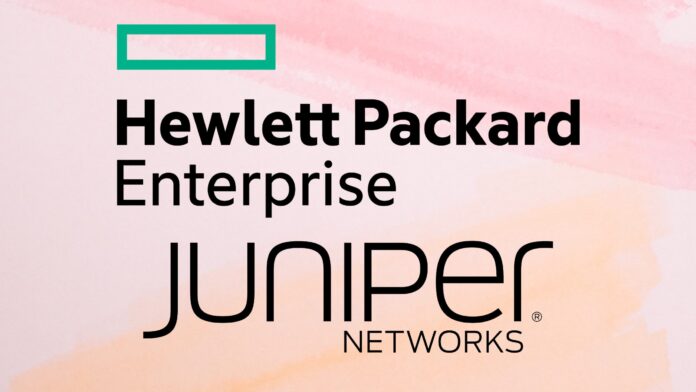Clearly, the focus of the initial response among the analyst community to HPE’s proposed $14 billion takeover of Juniper Networks, announced last week, has been on the latter’s artificial intelligence (AI) capabilities in the networking space, acquired and developed since its own purchase of Mist Systems in 2019. In particular, market watchers noted how Juniper’s Mist AI portfolio has underpinned its rising influence in the enterprise networking space, and wondered about what the combination with HPE’s networking unit buys.
But they also wondered variously about “significant” product overlap and difficult product integration, including how Juniper’s enterprise and telecoms networking units jigsaw together with HPE’s niche private networking unit Athonet, but mostly whether its telecoms business will be sidelined, as telecoms takes the fall for the combined firm’s enterprise focus, and even whether it will survive. All these points are raised in the below discussion (with more questions than answers, invariably); but we start with the headline-making logic about the “premium” value of Juniper’s AI-loaded enterprise networking proposition.
“It changes the enterprise networking landscape significantly,” remarked Sian Morgan, research director at Dell’Oro Group in a blog post on social media. Dell’Oro put HPE’s share of the wireless local-area network (WLAN) market at 13 percent “in the first three quarters of 2023”, among enterprises; by contrast Juniper was down at four percent in the period. So why the fuss? Because Juniper is taking share at a faster rate, where it counts, among big-sized cloud-savvy enterprises. “Mist AI for enterprise has been on a rocket-ship trajectory over the past four years,” said Morgan.

“It has been displacing market leaders Cisco and HPE with Fortune 100 companies who are becoming more open to cloud-managed networking. By contrast, HPE Aruba has been underperforming in cloud WLAN, with market share around the six percent mark.” Juniper surpassed HPE in cloud-managed WLAN revenues back in 2020, calculates Dell’Oro. But Aruba has its own sweet spot in the supply of Wi-Fi 6E access points; it shipped more than “even Cisco” in 2022, said Morgan, and its 6E gear has won awards (Wi-Fi Now) for its Akoustis filters, maximising 6 GHz usage.
The acquisition would double HPE’s networking business, increasing from around 18 percent of its total annual revenue to 31 percent, based on 2023 numbers; the combined networking business would represent more than 56 percent of HPE’s total operating income. The plan is that respective product and service capabilities will coexist, along with the brands, in the new Aruba/Mist combination, which will mainline AI for information (and IT-based communication) technology (AIOps) for both enterprise customers and telecoms providers.
The Mist AI portfolio will be integrated into HPE’s pay-as-you-go IT services cloud, GreenLake – as part of the Aruba Central proposition. The pair expect to achieve operating efficiencies of $450 million per annum within 36 months of the deal’s close, expected in late 2024 or early 2025. Morgan said: “HPE is targeting not just capturing share of the networking market, but also higher margins. HPE has excelled in growing profitability in the past few quarters.” But the sense is the Aruba/Mist combo is all about enterprises, potentially to the cost of traditional telecoms operators.

Robert Curran, consulting analyst at Appledore Research, responded: “HPE’s core business areas of compute and storage have been declining, so it needed a new direction for growth… HPE’s management has been keen to stress this was not just about enterprise, but there wasn’t much shared about anything that wasn’t enterprise.” As an aside, he suggested the “price premium” on the $14 billion deal, representing a 32 percent advance (at $40 per share) on the firm’s closing price last week, is “good news for Juniper shareholders, of course”.
Curran went on: “Being a software business acquired into a hardware company is hard. Being a telco business folded in an enterprise company is also hard – not impossible, but difficult. We were not the only ones surprised by the lack of reference in calls to HPE’s telecom unit. The deal certainly helps HPE burnish its enterprise offerings.” He pointed also to Juniper’s service assurance suite (Paragon, which includes Netrounds; acquired in 2020), alongside the MistAI portfolio, as a modish smart networking play – for “resolving network issues using AI and automation”.
Moor Insights & Strategy issued a research note last week that said much the same – about Juniper’s rapid success with AI networks for enterprises, and HPE’s parallel need for AI in its networking portfolio. “Juniper’s acquisition of Mist Systems in 2019 was a smart move,” said Patrick Moorhead, chief executive at the firm. “Mist’s value… is firmly rooted in AI… By all measures, the Mist acquisition has been a success, with Juniper growing its enterprise base faster than its service provider business over the last 12-to-18 months.”

He added: “HPE is likely seeking a strong AI anchor for its portfolio of hardware, software, and IT consumption services… AI is hot… [and] one could argue that beyond the AIOps capability found in the HPE Aruba portfolio today, HPE needs further AI depth to remain competitive and continue to grow its top-line revenue and profitability. Juniper could deliver on that front.” But again, all the talk is about enterprise networks – or at least the sense of the deal is more clearly perceived in relation to enterprises, where the crossover for telecoms operators looks a little obscure.
Yih-Khai Wong, senior analyst at ABI Research suggested the deal makes good on Juniper’s ambition to pivot away from telecoms, to square-up in the enterprise sector via HPE’s well-oiled global reseller channels. “[This deal] signifies Juniper’s intention to accelerate… to an enterprise-first solution provider… [It] will enable Juniper to leverage HPE’s significant expertise in enterprise selling and an established global channel ecosystem,” he commented, also noting HPE’s access to giant-sized cloud customers (“the likes of AWS and Microsoft Azure”).
Like Curran, Wong scratched his head at the implications for Juniper’s traditional telecoms base. “Theoretically, HPE also adds significant telco capabilities, inheriting Juniper’s telco networking solutions,” he said; the emphasis, here, is on the ‘theoretical’. He added: “With the focus on enterprise and minimal telco presence from HPE, Juniper will have to face the risk of convincing its telco customers of the merits of this acquisition. Telco operators might be worried that this acquisition will mean less focus and innovation from Juniper, resulting in a deteriorating relationship.”
Moorhead at Moor Insights & Strategy reflected: “Juniper’s RAN Intelligent Controller (RIC) platform and mobile operator base could be a boon to HPE’s telecoms unit,” before making ‘telecoms’ into an enterprise channel-play, as well, by dropping the A-bomb – private networking unit Athonet, acquired by HPE about a year ago – into the mix. “[It could complement] Athonet to also provide private networking services for enterprises,” he said. But Wong is less convinced, suggesting Juniper’s hardcore telco service and innovation business is up in the air.

Wong said: “This can be taken as a win for the cloud and data center infrastructure space and a potential loss to mobile operators… Telco is the question that needs answering. Juniper has a sizeable telco business, although it has been shrinking [with] the focus on enterprise. Will HPE integrate it into its Athonet portfolio? Will Juniper be asked to continue running the telco customers separately given its expertise in the telco industry? Or will this segment be sold off to recoup some of the financial investment that HPE had to make to acquire Juniper?”
On Athonet, Curran at Appledore responded: “We doubt there is much impact either way on Athonet from this particular deal. That seemed fairly self-contained.” Meanwhile, Moorhead presented Dell Technologies as an external reference point. “It’s worth noting that Dell has [also] matured its telecom offerings. Acquiring Juniper could serve as a defensive strategy to allow HPE to take more telecoms share and thwart Dell’s efforts – which, until recently, was only selling common off-the-shelf (COTS) servers to mobile operators,” he said.
In a quick email exchange, Dean Bubley from Disruptive Analysis, argued: “The combination of Aruba and Mist is interesting, as is the combination of Mist and Athonet with HPE’s edge-cloud compute business. These combinations make for some interesting opportunities. But the real impact is probably more on mainstream enterprise and carrier networks – in routing and/ switching infrastructure, in other words.” Indeed, the biggest competitive target for a combined HPE/Juniper juggernaut, cited by everyone, is Cisco.
“Cisco is still the big player to beat within enterprise networking,” commented Curran. Wong at ABI Research called the conjoined proposition a “new networking powerhouse to challenge long-time incumbent Cisco”. Leonard Lee, executive analyst at neXt Curve, raised the prospect of a different high-stakes face-off, with Chinese telecoms firm Huawei. “From a global perspective, HPE and Juniper is a welcome but early challenge to Huawei which has quietly executed on its converged ICT evolution for years,” he said.

Lee called it “an aggressive acquisition”, and went on: “It has the potential to expand its plays in telecoms and fortify its hybrid-cloud play… with IT and CT technologies and products. Juniper adds significant enterprise and telco networking [plus] security heft to HPE’s existing Aruba portfolio and Athonet offerings acquired almost a year ago – making it an emergent leader in converged IT/CT infrastructure and security… The acquisition also positions the combined company well in cloud RAN and telco cloud, especially as open RAN finds firmer footing among operators.”
The integration of computing and connectivity into a single infrastructure bundle looks like a heady one, said Francis Haysom, principal analyst at Appledore Research, but not an easy one to pull off, and not one the market necessarily wants or needs, if history tells us anything. “[It would be] in a powerful position to enable a complete integrated edge-cloud infrastructure – a possible integrated market, but one that needs to have a compelling argument that this is better than buying compute / storage and networking separately.”
He went on: “We know that telcos positioned themselves pre-cloud in the data centre market as a one-stop shop for this and failed. The market chose to buy best-of-breed data centre and networking then and it is not clear anything has changed. Success will need to be more than just product (portfolio) coverage.” Indeed, portfolio rationalization looks more likely. Curran, his colleague at Appledore, perceives only “some overlap” in their enterprise network portfolios, mostly in the Aruba/Mist SD-WAN crossover, but “not a huge amount”.
Moorhead, meanwhile, sees a lot. “There is a significant overlap [in] networking portfolios. Serious roadmap rationalization will need to occur, and without a doubt, some solutions will be sunsetted.” And Sameh Boujelbene, vice president at Dell’Oro, sees a “significant challenge” in the “substantial product overlap,” across their switching, Wi-Fi, and security products. “The convergence of these product lines will be intriguing. Ideally, the merged portfolio should bolster the market share of the consolidated entities.”
Writing in a blog post, she added: “Regrettably, history has shown that not all product integration and consolidation meet that desired outcome.”
Product, sales, and marketing teams will all be “blended”, said Moorhead. He summed up: “If approved, the ultimate success of the acquisition will be measured by how quickly and skillfully HPE integrates Juniper. There are many moving parts to this transaction – deep product roadmap rationalization, talent retention, and channel partner reconstitution among them. But if HPE is successful, it could significantly improve its share of the enterprise networking market – and strengthen its communication service provider business at the same time.”
Haysom said: “Success for the merged company will ultimately come down to execution. In enterprise and telco, the piece-parts are there for a successful merger. But the jury is out on HPE’s culture being able to deliver this.”

